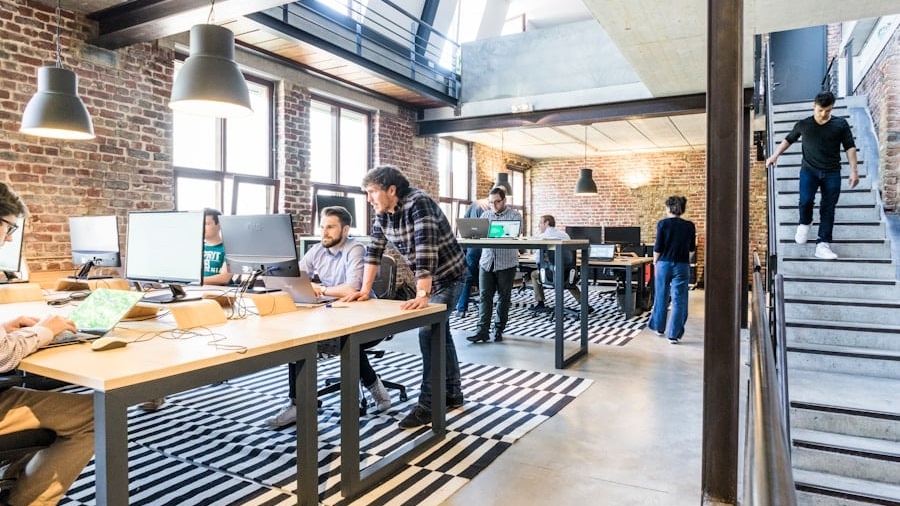The convergence of Artificial Intelligence (AI) and the Internet of Things (IoT) is revolutionizing the way we perceive and utilize workspaces. As organizations strive for greater efficiency, productivity, and employee satisfaction, the integration of these advanced technologies is becoming increasingly prevalent. AI refers to the simulation of human intelligence processes by machines, particularly computer systems, which can perform tasks such as learning, reasoning, and problem-solving.
On the other hand, IoT encompasses a network of interconnected devices that communicate and exchange data over the internet, enabling real-time monitoring and control of various systems. In modern work environments, the synergy between AI and IoT is creating smarter workspaces that adapt to the needs of employees and organizations alike. This transformation is not merely about upgrading technology; it represents a fundamental shift in how work is conducted.
By harnessing the power of AI and IoT, businesses can create environments that are not only more efficient but also more conducive to collaboration and innovation. The implications of this integration extend beyond mere operational improvements; they touch on employee well-being, sustainability, and the overall future of work.
Key Takeaways
- AI and IoT are revolutionizing workspaces by creating smarter and more efficient environments for employees.
- AI plays a crucial role in analyzing data and making real-time decisions to optimize workspace operations and enhance employee experience.
- IoT devices and sensors are improving productivity in workspaces by providing valuable insights into space utilization, energy consumption, and employee behavior.
- Integrating AI and IoT technologies can lead to enhanced workspace efficiency through automation, predictive maintenance, and personalized experiences for employees.
- The benefits of AI and IoT in workspaces include improved productivity, cost savings, better decision-making, and enhanced employee satisfaction.
The Role of AI in Creating Smarter Workspaces
AI plays a pivotal role in the evolution of smarter workspaces by automating routine tasks, enhancing decision-making processes, and personalizing employee experiences. One of the most significant contributions of AI is its ability to analyze vast amounts of data quickly and accurately. For instance, AI algorithms can sift through employee performance metrics, project timelines, and resource allocations to provide insights that help managers make informed decisions.
This data-driven approach not only streamlines operations but also empowers employees by providing them with the tools they need to excel in their roles. Moreover, AI-driven virtual assistants are becoming commonplace in workplaces, assisting employees with scheduling meetings, managing emails, and even providing reminders for important tasks. These intelligent systems learn from user interactions, becoming increasingly adept at anticipating needs and preferences over time.
For example, an AI assistant might suggest optimal meeting times based on participants’ availability or recommend relevant documents based on the context of a project. This level of personalization enhances productivity by allowing employees to focus on high-value tasks rather than getting bogged down by administrative duties.
The Impact of IoT on Productivity in Workspaces

The Internet of Things has a profound impact on productivity within workspaces by enabling seamless connectivity between devices and systems. IoT devices can monitor various aspects of the workplace environment, such as temperature, lighting, and occupancy levels, allowing for real-time adjustments that enhance comfort and efficiency. For instance, smart thermostats can learn employee preferences and adjust heating or cooling accordingly, ensuring that the workspace remains conducive to productivity throughout the day.
Additionally, IoT technology facilitates better resource management by providing insights into how spaces are utilized. Companies can deploy sensors to track occupancy in meeting rooms or collaborative spaces, enabling them to optimize layouts and reduce wasted resources. For example, if data shows that certain meeting rooms are consistently underutilized, organizations can repurpose those spaces for more collaborative activities or even convert them into relaxation areas.
This data-driven approach not only maximizes space efficiency but also fosters a culture of adaptability within the organization.
Integrating AI and IoT for Enhanced Workspace Efficiency
The integration of AI and IoT technologies creates a powerful ecosystem that enhances workspace efficiency in unprecedented ways. By combining the analytical capabilities of AI with the real-time data collection capabilities of IoT devices, organizations can achieve a level of operational insight that was previously unattainable. For instance, smart building management systems can leverage IoT sensors to monitor energy consumption patterns while AI algorithms analyze this data to identify opportunities for cost savings and sustainability improvements.
IoT sensors can detect anomalies in machinery or systems—such as unusual vibrations in HVAC units or irregular power consumption in office equipment—while AI can analyze historical data to predict when maintenance is required. This proactive approach minimizes downtime and extends the lifespan of assets, ultimately leading to significant cost savings for organizations.
Benefits of AI and IoT in Workspaces
The benefits of integrating AI and IoT into workspaces are manifold, ranging from enhanced productivity to improved employee satisfaction. One of the most notable advantages is the ability to create a more flexible work environment that adapts to individual needs. With smart technologies in place, employees can customize their workspace settings—such as lighting and temperature—through mobile applications or voice commands, fostering a sense of ownership over their work environment.
Moreover, the data generated by IoT devices can inform strategic decision-making at all levels of an organization. By analyzing patterns in employee behavior and workspace utilization, leaders can make informed choices about resource allocation, office design, and even workforce planning. This data-driven approach not only enhances operational efficiency but also contributes to a culture of transparency and collaboration within the organization.
Challenges and Considerations in Implementing AI and IoT in Workspaces

Data Privacy and Security Concerns
One significant concern when integrating AI and IoT in workspaces is data privacy and security. As organizations collect vast amounts of data from connected devices, they must implement robust security measures to protect sensitive information from cyber threats. This includes encryption protocols, access controls, and regular security audits to safeguard against potential breaches.
Addressing Employee Resistance to Change
Another challenge is the resistance to change among employees when new technologies are introduced. Organizations must invest in training programs that not only educate employees about how to use new tools but also emphasize the benefits these technologies bring to their daily work lives.
Fostering a Culture of Innovation
Fostering a culture that embraces innovation requires clear communication about how AI and IoT will enhance rather than replace human roles within the organization.
Case Studies of Successful AI and IoT Implementation in Workspaces
Several organizations have successfully implemented AI and IoT technologies to transform their workspaces into more efficient environments. One notable example is Siemens, which has integrated smart building technologies across its offices worldwide. By utilizing IoT sensors to monitor energy usage and occupancy levels, Siemens has achieved significant reductions in energy consumption while enhancing employee comfort through optimized climate control systems.
Another compelling case is that of Google’s campus in Mountain View, California. The tech giant employs a range of smart technologies that leverage both AI and IoT to create an innovative workspace. From automated lighting systems that adjust based on natural light levels to advanced air quality monitoring systems that ensure optimal working conditions, Google’s approach exemplifies how integrating these technologies can lead to enhanced employee well-being and productivity.
Future Trends and Developments in AI and IoT for Workspaces
Looking ahead, the future of AI and IoT in workspaces promises even greater advancements as technology continues to evolve. One emerging trend is the increased use of machine learning algorithms that enable predictive analytics for workforce management. Organizations will be able to anticipate staffing needs based on historical data trends, seasonal fluctuations, and project demands, allowing for more agile workforce planning.
Additionally, as remote work becomes more prevalent, hybrid work models will necessitate further integration of AI and IoT technologies to ensure seamless collaboration between on-site and remote employees. Virtual reality (VR) and augmented reality (AR) tools may also play a role in creating immersive meeting experiences that bridge geographical gaps. As these technologies mature, they will redefine how teams collaborate across distances while maintaining a sense of connection and engagement.
In conclusion, the integration of AI and IoT into workspaces is not just a technological upgrade; it represents a fundamental shift in how organizations operate. By embracing these innovations, businesses can create environments that foster productivity, enhance employee satisfaction, and drive sustainable growth in an increasingly competitive landscape.
In a recent article on enicomp.com, they discuss the best shared hosting services in 2023, highlighting the importance of reliable and efficient web hosting for businesses looking to establish an online presence. This article complements the discussion on how AI and IoT are creating smarter and more productive workspaces by emphasizing the role of technology in optimizing digital operations. To read more about the best shared hosting services, check out the article here.
FAQs
What is AI and IoT?
AI, or artificial intelligence, refers to the simulation of human intelligence in machines that are programmed to think and act like humans. IoT, or the Internet of Things, refers to the network of physical devices, vehicles, home appliances, and other items embedded with electronics, software, sensors, and connectivity which enables these things to connect and exchange data.
How are AI and IoT being used in workspaces?
AI and IoT are being used in workspaces to create smarter and more productive environments. This includes using sensors to monitor and control lighting, temperature, and air quality, as well as using AI to analyze data and make predictions to optimize workspace efficiency.
What are the benefits of using AI and IoT in workspaces?
The benefits of using AI and IoT in workspaces include improved energy efficiency, enhanced employee productivity, better space utilization, and the ability to create personalized and adaptive work environments.
Are there any concerns about using AI and IoT in workspaces?
Some concerns about using AI and IoT in workspaces include data privacy and security risks, potential job displacement due to automation, and the need for proper training and education to effectively utilize these technologies.

